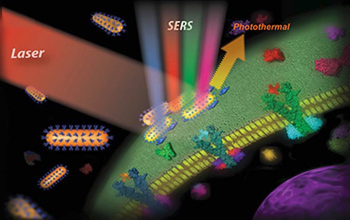Multimedia Gallery
Arkansas institutions are collaborating on a state-wide center to develop multi-functional surfaces.
Nanostructural materials with tunable architectures and morphologies present unique electrical, optical, magnetic or mechanical properties. Such nanomaterials will be synthesized and their complex interactions with various biological systems will be tested to fully understand how their morphology controls their characteristics and ability to be used as highly sensitive agents to control biological processes. Such multifunctional materials will have applications in the areas of advanced materials, nanomedicine, sensing, or biology. Plasmonically active nanostructures with strong spectroscopic signatures can be used for biomedical applications.
Credit: Zeid Nima, Center for Integrative Nanotechnology Sciences, University of Arkansas at Little Rock
Images credited to the National Science Foundation, a federal agency, are in the public domain. The images were created by employees of the United States Government as part of their official duties or prepared by contractors as "works for hire" for NSF. You may freely use NSF-credited images and, at your discretion, credit NSF with a "Courtesy: National Science Foundation" notation.
Additional information about general usage can be found in Conditions.
Also Available:
Download the high-resolution JPG version of the image. (72.8 KB)
Use your mouse to right-click (Mac users may need to Ctrl-click) the link above and choose the option that will save the file or target to your computer.
Related story: NSF invests in science and engineering infrastructure across the nation



